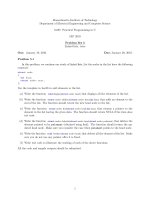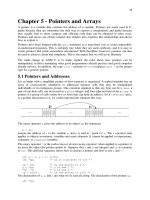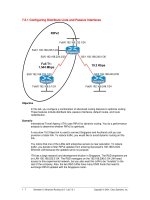Pointers and Linked Lists
Bạn đang xem bản rút gọn của tài liệu. Xem và tải ngay bản đầy đủ của tài liệu tại đây (1.98 MB, 80 trang )
Copyright © 2007 Pearson Education, Inc. Publishing as Pearson Addison-Wesley
Chapter 13
Pointers and Linked Lists
Slide 13- 3
Copyright © 2007 Pearson Education, Inc. Publishing as Pearson Addison-Wesley
Overview
13.1 Nodes and Linked Lists
13.2 Stacks and Queues
Copyright © 2007 Pearson Education, Inc. Publishing as Pearson Addison-Wesley
13.1
Nodes and Linked Lists
Slide 13- 5
Copyright © 2007 Pearson Education, Inc. Publishing as Pearson Addison-Wesley
10
12
end
14
head
Nodes and Linked Lists
A linked list is a list that can grow and shrink
while the program is running
A linked list is constructed using pointers
A linked list often consists of structs or classes
that contain a pointer variable connecting them
to other dynamic variables
A linked list can be visualized as items, drawn
as boxes, connected to other items by arrows
Slide 13- 6
Copyright © 2007 Pearson Education, Inc. Publishing as Pearson Addison-Wesley
Display 13.1
Nodes
The boxes in the previous drawing represent the
nodes of a linked list
Nodes contain the data item(s) and a pointer
that can point to another node of the same
type
The pointers point to the entire node, not an
individual item that might be in the node
The arrows in the drawing represent pointers
Slide 13- 7
Copyright © 2007 Pearson Education, Inc. Publishing as Pearson Addison-Wesley
Nodes are implemented in C++ as structs or
classes
Example: A structure to store two data items and
a pointer to another node of the same type,
along with a type definition might be:
struct ListNode
{
string item;
int count;
ListNode *link;
};
typedef ListNode* ListNodePtr;
This circular definition
is allowed in C++
Implementing Nodes
Slide 13- 8
Copyright © 2007 Pearson Education, Inc. Publishing as Pearson Addison-Wesley
The head of a List
The box labeled head, in display 13.1, is not a
node, but a pointer variable that points to a node
Pointer variable head is declared as:
ListNodePtr head;
Slide 13- 9
Copyright © 2007 Pearson Education, Inc. Publishing as Pearson Addison-Wesley
Accessing Items in a Node
Using the diagram of 13.1, this is one way to
change the number in the first node from
10 to 12:
(*head).count = 12;
head is a pointer variable so *head is the node
that head points to
The parentheses are necessary because the
dot operator . has higher precedence than the
dereference operator *
Slide 13- 10
Copyright © 2007 Pearson Education, Inc. Publishing as Pearson Addison-Wesley
Display 13.2
The Arrow Operator
The arrow operator -> combines the actions of
the dereferencing operator * and the dot operator
to specify a member of a struct or object pointed
to by a pointer
(*head).count = 12;
can be written as
head->count = 12;
The arrow operator is more commonly used
Slide 13- 11
Copyright © 2007 Pearson Education, Inc. Publishing as Pearson Addison-Wesley
NULL
The defined constant NULL is used as…
An end marker for a linked list
A program can step through a list of nodes by
following the pointers, but when it finds a node
containing NULL, it knows it has come to the end of
the list
The value of a pointer that has nothing to point
to
The value of NULL is 0
Any pointer can be assigned the value NULL:
double* there = NULL;
Slide 13- 12
Copyright © 2007 Pearson Education, Inc. Publishing as Pearson Addison-Wesley
To Use NULL
A definition of NULL is found in several
libraries, including <iostream> and <cstddef>
A using directive is not needed for NULL
Slide 13- 13
Copyright © 2007 Pearson Education, Inc. Publishing as Pearson Addison-Wesley
Linked Lists
The diagram in Display 13.2 depicts a linked list
A linked list is a list of nodes in which each node
has a member variable that is a pointer that
points to the next node in the list
The first node is called the head
The pointer variable head, points to the first
node
The pointer named head is not the head of the list…it
points to the head of the list
The last node contains a pointer set to NULL
Slide 13- 14
Copyright © 2007 Pearson Education, Inc. Publishing as Pearson Addison-Wesley
Building a Linked List:
The node definition
Let's begin with a simple node definition:
struct Node
{
int data;
Node *link;
};
typedef Node* NodePtr;
Slide 13- 15
Copyright © 2007 Pearson Education, Inc. Publishing as Pearson Addison-Wesley
Building a Linked List:
Declaring Pointer Variable head
With the node defined and a type definition to
make or code easier to understand, we can
declare the pointer variable head:
NodePtr head;
head is a pointer variable that will point to the
head node when the node is created
Slide 13- 16
Copyright © 2007 Pearson Education, Inc. Publishing as Pearson Addison-Wesley
Building a Linked List:
Creating the First Node
To create the first node, the operator new is used
to create a new dynamic variable:
head = new Node;
Now head points to the first, and only, node in
the list
Slide 13- 17
Copyright © 2007 Pearson Education, Inc. Publishing as Pearson Addison-Wesley
Building a Linked List:
Initializing the Node
Now that head points to a node, we need to
give values to the member variables of the node:
head->data = 3;
head->link = NULL;
Since this node is the last node, the link is set
to NULL
Slide 13- 18
Copyright © 2007 Pearson Education, Inc. Publishing as Pearson Addison-Wesley
Function head_insert
It would be better to create a function to insert
nodes at the head of a list, such as:
void head_insert(NodePtr& head, int the_number);
The first parameter is a NodePtr parameter that points to the
first node in the linked list
The second parameter is the number to store in the list
head_insert will create a new node for the number
The number will be copied to the new node
The new node will be inserted in the list as the new head node
Slide 13- 19
Copyright © 2007 Pearson Education, Inc. Publishing as Pearson Addison-Wesley
Display 13.3
Pseudocode for head_insert
Create a new dynamic variable pointed to by
temp_ptr
Place the data in the new node called *temp_ptr
Make temp_ptr's link variable point to the head
node
Make the head pointer point to temp_ptr
Slide 13- 20
Copyright © 2007 Pearson Education, Inc. Publishing as Pearson Addison-Wesley
Display 13.4
Translating head_insert to C++
The pseudocode for head_insert can be written
in C++ using these lines in place of the lines of
pseudocode:
NodePtr temp_ptr; //create the temporary pointer
temp_ptr = new Node; // create the new node
temp_ptr->data = the_number; //copy the number
temp_ptr->link = head; //new node points to first node
head = temp_ptr; // head points to new
// first node
Slide 13- 21
Copyright © 2007 Pearson Education, Inc. Publishing as Pearson Addison-Wesley
An Empty List
A list with nothing in it is called an empty list
An empty linked list has no head node
The head pointer of an empty list is NULL
head = NULL;
Any functions written to manipulate a linked list
should check to see if it works on the empty list
Slide 13- 22
Copyright © 2007 Pearson Education, Inc. Publishing as Pearson Addison-Wesley
You might be tempted to write head_insert using
the head pointer to construct the new node:
head = new Node;
head->data = the_number;
Now to attach the new node to the list
The node that head used to point to is now
lost!
Display 13.5
Losing Nodes
Slide 13- 23
Copyright © 2007 Pearson Education, Inc. Publishing as Pearson Addison-Wesley
Memory Leaks
Nodes that are lost by assigning their pointers a
new address are not accessible any longer
The program has no way to refer to the nodes
and cannot delete them to return their memory
to the freestore
Programs that lose nodes have a memory leak
Significant memory leaks can cause system
crashes
Slide 13- 24
Copyright © 2007 Pearson Education, Inc. Publishing as Pearson Addison-Wesley
Searching a Linked List
To design a function that will locate a particular
node in a linked list:
We want the function to return a pointer to the
node so we can use the data if we find it, else
return NULL
The linked list is one argument to the function
The data we wish to find is the other argument
This declaration will work:
NodePtr search(NodePtr head, int target);
Slide 13- 25
Copyright © 2007 Pearson Education, Inc. Publishing as Pearson Addison-Wesley
Refining our function
We will use a local pointer variable, named
here, to move through the list checking for the
target
The only way to move around a linked list is to follow
pointers
We will start with here pointing to the first node
and move the pointer from node to node
following the pointer out of each node
Display 13.6
Function search









